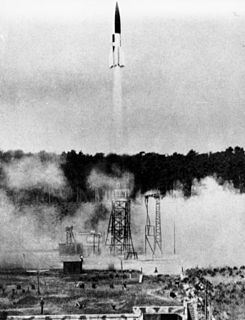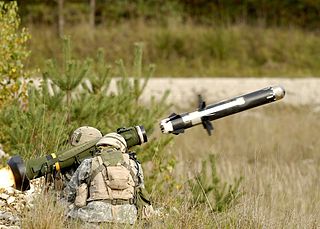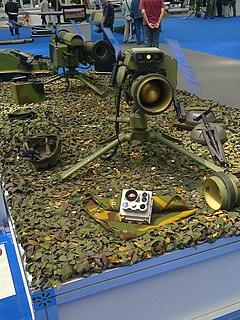
In modern language, a missile, also known as a guided missile or guided rocket, is a guided airborne ranged weapon capable of self-propelled flight usually by a jet engine or rocket motor. Missiles have four system components: targeting/guidance system, flight system, engine and warhead. Missiles come in types adapted for different purposes: surface-to-surface and air-to-surface missiles, surface-to-air missiles, air-to-air missiles, and anti-satellite weapons.

An anti-tank guided missile (ATGM), anti-tank missile, anti-tank guided weapon (ATGW) or anti-armor guided weapon is a guided missile primarily designed to hit and destroy heavily armored military vehicles.

MBDA is a European developer and manufacturer of missiles. It was formed as a joint venture by a merger of the guided missile divisions of EADS, Finmeccanica, and BAE Systems in December 2001. In 2016 the company had more than 10,500 employees. In 2017, MBDA recorded orders for €4.2 bn and an order book of €16.8 bn. The company name is an initialism of the names of the companies that came together to form it: Matra; BAe Dynamics and Alenia. MBDA works with over 90 armed forces worldwide.

MILAN is a Western European anti-tank guided missile. Design of the MILAN started in 1962, it was ready for trials in 1971, and was accepted for service in 1972. It is a wire guided SACLOS missile, which means the sight of the launch unit has to be aimed at the target to guide the missile. The MILAN can be equipped with a MIRA or MILIS thermal sight to give it night-firing ability.

The FGM-148 Javelin is an American man-portable fire-and-forget anti-tank missile fielded to replace the M47 Dragon anti-tank missile in US service. It uses automatic infrared guidance that allows the user to seek cover immediately after launch, as opposed to wire-guided systems, like the Dragon, which require the user to actively guide the weapon throughout the engagement. The Javelin's HEAT warhead is capable of defeating modern tanks by attacking them from above where their armor is thinnest, and is also useful against fortifications in a direct attack flight.

The BGM-71 TOW is an American anti-tank missile. TOW replaced much smaller missiles like the SS.10 and ENTAC, offering roughly twice the effective range, a more powerful warhead, and a greatly improved semi-automatic guidance system that could also be equipped with infrared cameras for night time use.

The Aster missile series, primarily comprising the Aster 15 and Aster 30 are a family of Franco-Italian vertically launched surface-to-air missiles. The name "Aster" stands for " Aérospatiale Terminale " and from the mythical Greek archer named Asterion, Asterion likewise receiving his name from the ancient Greek word aster, meaning "star". Aster is manufactured by Eurosam, a European consortium consisting of MBDA France, MBDA Italy and the Thales Group (33%).

The M72 LAW is a portable one-shot 66-mm unguided anti-tank weapon. The solid rocket propulsion unit was developed in the newly formed Rohm and Haas research laboratory at Redstone Arsenal in 1959, then the full system was designed by Paul V. Choate, Charles B. Weeks, Frank A. Spinale, et al. at the Hesse-Eastern Division of Norris Thermadore. American production of the weapon began by Hesse-Eastern in 1963, and was terminated by 1983; currently it is produced by Nammo Raufoss AS in Norway and their subsidiary Nammo Talley, Inc. in Arizona.

The M47 Dragon, known as the FGM-77 during development, is an American shoulder-fired, man-portable anti-tank guided missile system. It was phased out of U.S. military service in 2001, in favor of the newer FGM-148 Javelin system.

The HOT is a second-generation long-range anti-tank missile system developed originally as an effort to meet a joint German-French Army requirement, by the then German firm Bölkow and the French firm Nord, to replace the older SS.11 wire guided missile which was in service with both nations. A few years later, Bölkow and Nord merged into MBB and Aérospatiale respectively, both of which firms later formed Euromissile to design and produce the MILAN, Roland and HOT.

The 9M14 Malyutka is a manual command to line of sight (MCLOS) wire-guided anti-tank guided missile (ATGM) system developed in the Soviet Union. It was the first man-portable anti-tank guided missile of the Soviet Union and is probably the most widely produced ATGM of all time—with Soviet production peaking at 25,000 missiles a year during the 1960s and 1970s. In addition, copies of the missile have been manufactured under various names by at least five countries.

The 9M113 Konkurs is a Soviet SACLOS wire-guided anti-tank missile.

9K114 Shturm - is a SACLOS radio guided anti-tank missile system of the Soviet Union. Its GRAU designation is 9K114. Its NATO reporting name is AT-6 Spiral. The missile itself is known as the 9M114 Kokon (Cocoon).

SS.11 is the designation of the Nord Aviation MCLOS wire-guided anti-tank missile. In American service, the missile was designated the AGM-22. The missile entered service with the French Army in 1956. Production of the SS.11/SS.12 series ceased some time in the 1980s, by which time over 170,000 had been sold. The price of the SS.11 in the late 1960s was stated at approximately $1,900 U.S. dollars.
The SS.12 and AS.12 are two variants of the same missile: SS for surface-to-surface and AS for air-to-surface. It was designed in 1955-1957 by Nord Aviation, later Aérospatiale. It was a derivative of the NORD SS-10 and SS-11 missiles which were surface-to-surface wire-guided missiles for use by infantry, vehicle or a helicopter primarily in the anti-tank role, but also anti-material, anti-personnel and against light field fortifications. The SS.12/AS.12 was basically a scaled-up version of the SS.11/AS.11, with a massive increase in range and warhead weight. The SS.12/AS.12 original mission was primarily to be anti-shipping from naval helicopters and combat aircraft or ground launchers, and secondarily for use against heavy field fortifications. The range and the destructive power of its warhead are roughly equivalent to a 5-inch artillery shell.

The LRAC F1, officially called Lance-Roquettes AntiChar de 89 mm modèle F1 is a French reusable rocket launcher developed by Luchaire Défense SA, and manufactured in cooperation with Manufacture Nationale d'Armes de Saint-Étienne and was in the 1970s marketed by Hotchkiss-Brandt.

Cirit is a laser-guided 70 mm missile system under production by Turkish arms industry manufacturer ROKETSAN. It is one of the projects launched by Turkey to equip the Turkish Army's T-129 Atak, AH-1P Cobra and AH-1W Super Cobra attack helicopters with low-cost precision strike capabilities. It has been selected by Eurocopter for execution of a test and integration program to equip the Eurocopter EC635. The weapon's name comes from a traditional Turkish horseback game, Cirit, where two teams of riders fight a mock battle using wooden javelins which are called cirit.

The BUMBAR is a short-range portable anti-tank missile system developed and produced by Serbia.

Missile Moyenne Portée is a French man-portable anti-tank guided missile. It was developed by MBDA Missile Systems and is intended as a replacement for their MILAN, which has been sold worldwide.



















